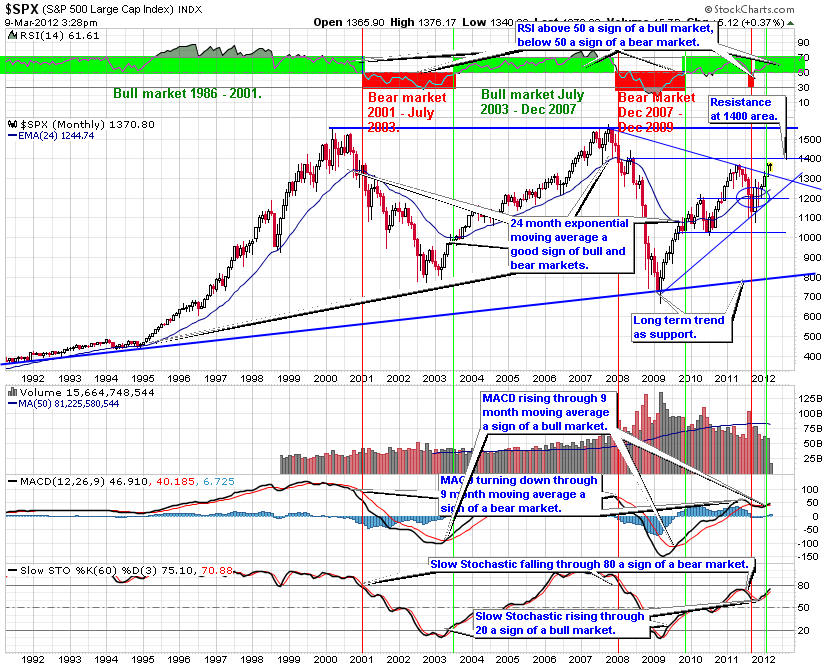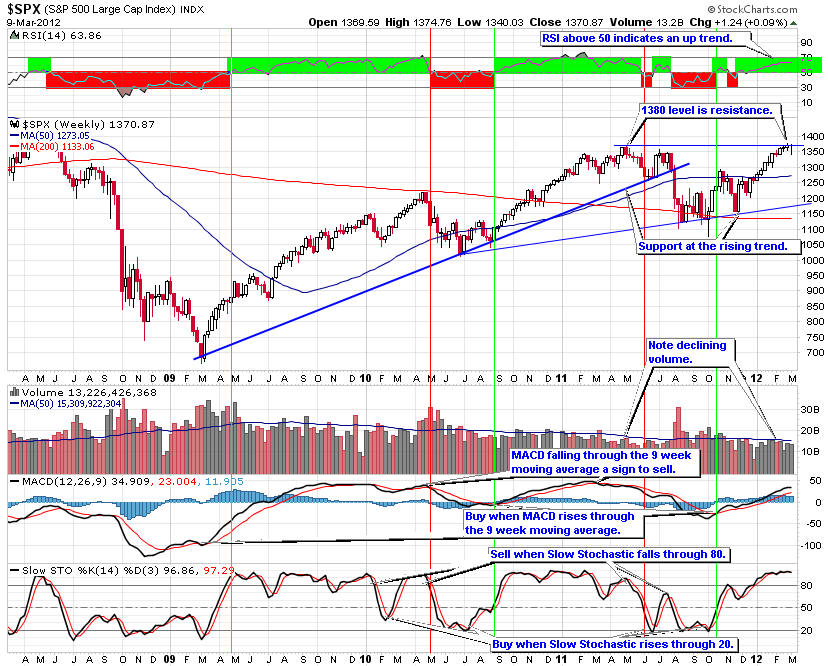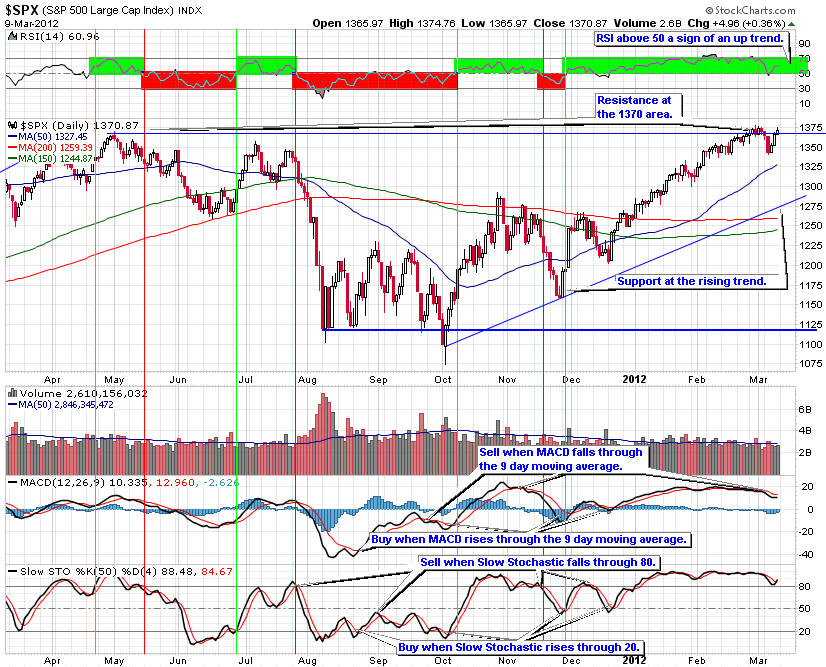

Starting with the indexes gives an overall perspective to the markets. This is monthly chart for the S&P 500 showing 20 years of performance. Since this index is the one used by professional traders it is important to understand how it is performing. This chart is also excellent at defining the longer term trends for the market.
The bull market of the last five years broke down when the S&P 500 turned down through the 24 month exponential moving average. The bear market began when the index fell through the 24-month exponential moving average. Also, the RSI tested the 50 level, another important indicator of bear markets (if the RSI remains below 50 then we are in a bear market) and turned back down. The MACD crossing down through zero is another sign of the transition from bear market to bull market. Finally, the Slow Stochastic fell through 80 as another sign of the beginning of the bear market.
In June 2010, the market fell through the 24-month exponential moving average. In July, the index closed above the 24-month EMA, indicating the rally may begin again. Unfortunately in August 2010 the S&P 500 once again closed below the 24-month EMA. Should the S&P 500 hold above the 24-month EMA, it will signal the bull market is back.
The RSI is at the 50 level a sign of indecision. The MACD is poised to turn down. Monitor how it handles the zero level to get an idea of the strength of this move. If the MACD turns down through its 9-month moving average it will be a sell sign. The Slow Stochastic turned down at the 50 level, indicating another bear market is beginning though it might be turning back up. If it does, it signals a market rally is underway.
From a monthly chart perspective the rally is faltering. Any further move down from here will indicate a new bear market is beginning.
You can click on the link below to see a current version of this chart.

The four-year weekly S&P 500 trend chart shows the turn down at the 200-week moving average and the 1,250 area as it trends sideways. There is support at the 940 area and resistance at the 200-week moving average.
RSI is at 50 a sign of indecision. The MACD fell through the 9-week moving average, giving a sell signal, though it might be turning up. The Slow Stochastic rebounded at the 20 area, a buy sign and it is rising through 50, a sign of strength.
The trend on the weekly S&P 500 is sideways between defined support and resistance.

The S&P demonstrates a useful learning pattern. First, the attempt to push up through the 50-day moving average in the middle of May failed, a sign of a new move down. Next this move up formed a lower high another indication the market was about to fall further. Both are excellent chart patterns telling us the market would turn down. The 50-day moving average will offer resistance on the next attempt to rally.
Now to the present. The S&P 500 rebounded on a test of minor support at the 1,050 area. Unfortunately volume has been about average, indicating many buyers are not joining in the rally. There is resistance at the 1,125 area and the 200-day moving average. The 1,050 provides some support as well as the neckline of the head and shoulders formation.
RSI is above 50 a sign of an up trend. The MACD turned up though its 9-day moving average, giving a buy sign. The Slow Stochastic turned up before reaching 20, a sign of strength.
The slope of the 150-day moving average is another important indicator. When it slopes up it is telling us the trend is up. when it points down the trend is down. Until the last few days the slope of the 150-day moving average was up. Now it is flat. If the market can move above the 150-day moving average, we can be assured the slope will remain positive. We will watch this carefully.
A head and shoulders pattern has formed, a bearish formation. A second shoulder formed and now the market is trying to rebound once again. It needs to take out resistance at the 1,125 area to negate the head and shoulders formation. If the index falls through the 1,050 level look for a drop to the 900 level based on the measure rule.
I suspect this current rally will end soon and we will once again see a pull back. Since September is noted as the worst months for the market it pays to be cautious and pay attention to that the market is telling us.
You can link to a current version of this chart below.

Given this analysis of the S&P 500 trend line charts, it is important to position your portfolio for a market that is more likely to trend in a range with cyclical rallies and pull backs.
Selecting the right sectors and stock picking will become more important to your success. Look to buy on dips in the market to important support levels. Then add down side protection at interim high points using trailing stops and protective put options to help improve the overall return.
The charts of the S&P 500 trend lines provide a good way for investors to align their portfolios with the overall market trends. Picking the right sectors and stocks will become even more important. Look to buy on dips in the price of the S&P 500 trend charts on the next pull back.
Be sure to use proper capital management techniques including trailing stops, protective put, covered call options and position sizing. When the pull back ends, look to add to long positions with stocks and ETFs from the sectors that are likely to outperform the overall market. Keep in mind, Warren Buffett's first rule of investing is to not lose money. Be patient waiting for good entry points.
As of the end of august 2010, our Stock Portfolio was up 8.5 percent and our sector portfolio was up 7.6 percent. The market as measured by the S&P 500 was down 4.3% for 2010.
Request a membership with a free four week trial subscription with no risk or obligation.
If you decide to continue at the end of the four-week trial your subscription starts automatically. If you decide to cancel before the end of the trial, you will not be charged a thing. No risk, no obligation.
You have nothing to lose and a lot to gain as we have beat the market every year since our inception.
If you are interested in a free monthly newsletter on the stock market trends, please send an email to [email protected] with your email address stating you wish to receive the Free Monthly Newsletter and you will be added to the list.